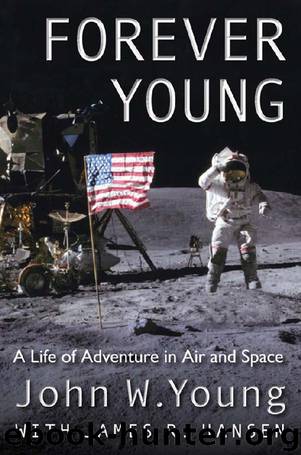Forever Young: A Life of Adventure in Air and Space by John W Young

Author:John W Young [Young, John W]
Language: eng
Format: epub, azw3
ISBN: 9780813042817
Publisher: University Press of Florida
Published: 2012-09-16T04:00:00+00:00
16
“The Boldest Test Flight in History”
At the time of the first flight of the space shuttle, there were fourteen pilot-astronauts. They all wanted to fly on the first flight. George Abbey was the deputy director of Flight Crew Operations. He picked Bob Crippen and me to serve as the STS-1 crew. Backing us up were Joe Engle and Dick Truly, who were to launch as the STS-2 crew. T. K. Mattingly and Henry Hartsfield were to fly on STS-3.
All of us pilot-astronauts were seriously concerned about the possibility of surviving a problem with the solid rocket boosters or external tank at launch. When the shuttle was first proposed, it had no “range safety” systems on it. Later a system was installed that could blow up the two SRBs and the ET, if necessary. To give the two-person crew a chance of emergency escape, the shuttle program put two ejection seats from the SR-71 Blackbird into a special cab the size of the orbiter flight deck and then sent it through runs on the test sleds at Holloman AFB on the White Sands Missile Range. Initially, the escape system was set up to fire thin rectangular charges to release the overhead hatches at the top of the simulated orbiter flight deck, followed by the firing of the ejection seats. On the sled, this arrangement was tested at maximum dynamic pressure. Problem was, the SR-71 seats involved a lot of safety pins. For a shuttle crew, ejection with them at any altitude would have been very dangerous. Unlike most emergency scenarios involving the SR-71, shuttle pilots wore pressure suits and would have only seconds to eject before the range safety officers blew up our boosters, tank, or both. After STS-2, NASA declared the shuttle operational and de-armed the ejection seats; however, the range safety systems were not removed.
Obviously, as far as the range safety community was concerned, as well as what we knew technically, the shuttle was not operational and should not have been declared as such. Bob Gilruth, the JSC director, said we really didn’t need ejection seats because the shuttle was going to be “reliable as the DC-8.” Right after that, Bob Crippen and I visited the Rocketdyne folks who were building the shuttle’s main engines. They were having frequent engine turbo-pump failures. When the pumps failed, they threw fan blades that obliterated the main engines. Crip and I didn’t think of these failures as “DC-8-level reliability.”
My first flight in the shuttle training aircraft came in February 1977; at the controls of the C-11 Gulfstream II was an instructor, Ted Mendenhall. Training in the STA was critically important to successful shuttle piloting, as it came as close as possible to duplicating the shuttle’s approach profile and handling qualities. Flying it allowed us to get the feel of a shuttle landing under controlled conditions before attempting the task aboard the orbiter. What was learned from instructor pilots about landing the shuttle ended up saving many of us, not just in an actual orbiter but in the STA itself.
Download
Forever Young: A Life of Adventure in Air and Space by John W Young.azw3
This site does not store any files on its server. We only index and link to content provided by other sites. Please contact the content providers to delete copyright contents if any and email us, we'll remove relevant links or contents immediately.
| Africa | Americas |
| Arctic & Antarctica | Asia |
| Australia & Oceania | Europe |
| Middle East | Russia |
| United States | World |
| Ancient Civilizations | Military |
| Historical Study & Educational Resources |
Cat's cradle by Kurt Vonnegut(15128)
Pimp by Iceberg Slim(14270)
4 3 2 1: A Novel by Paul Auster(12245)
Underground: A Human History of the Worlds Beneath Our Feet by Will Hunt(11992)
The Radium Girls by Kate Moore(11886)
Wiseguy by Nicholas Pileggi(5626)
Perfect Rhythm by Jae(5293)
American History Stories, Volume III (Yesterday's Classics) by Pratt Mara L(5234)
The Fire Next Time by James Baldwin(5215)
Paper Towns by Green John(5057)
Pale Blue Dot by Carl Sagan(4880)
A Higher Loyalty: Truth, Lies, and Leadership by James Comey(4813)
The Mayflower and the Pilgrims' New World by Nathaniel Philbrick(4392)
The Doomsday Machine by Daniel Ellsberg(4386)
Killers of the Flower Moon: The Osage Murders and the Birth of the FBI by David Grann(4363)
The Sympathizer by Viet Thanh Nguyen(4278)
Too Much and Not the Mood by Durga Chew-Bose(4247)
The Borden Murders by Sarah Miller(4210)
Sticky Fingers by Joe Hagan(4077)
